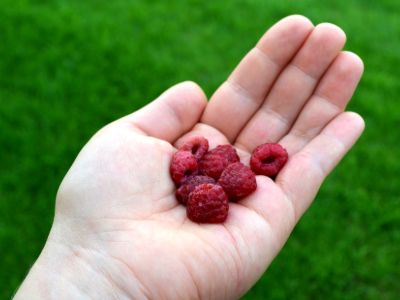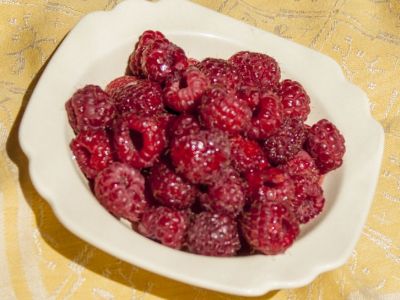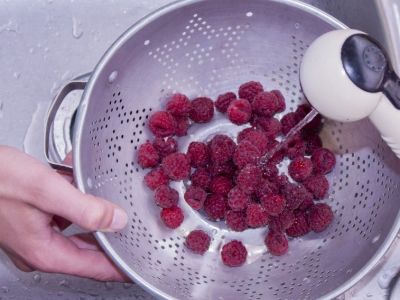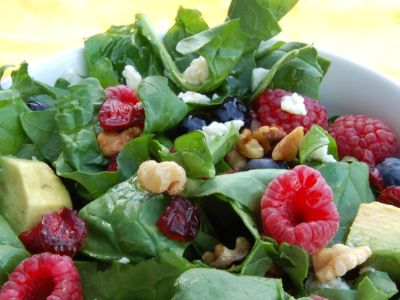Raspberries

Preparation: Step-by-Step

Harvest fruit early in the morning and cool immediately to
protect quality. Keep store-purchased raspberries cool.

Store raspberries in half-pint containers. If a larger
container is used, bottom fruit may be crushed.

Wash hands prior to rinsing raspberries. Do not rinse
berries until ready to eat. Rinse raspberries thoroughly
by placing under running water in hand or a colander.

Enjoy fresh, add to salads or drinks,
bake, puree, or preserve.
Grow.
- Plant disease-free raspberry plants in the early spring in rows six feet apart with
plants
spaced every 2-3 feet. Set bareroot plants in well-drained soil with a pH of between 5.5 and 6.5.
In a shallow hole wide enough to accommodate the roots, spread the roots out so that the
crown (where the roots meet the stem) is 1-2 inches below the ground. Cover with soil and firm
in to remove air pockets. Water well and cut canes back to six inches above the ground. Newly
planted canes will not produce fruit the first year, and possibly not the second, but will provide a mature crop in the third year. For more growing information look for the MontGuide,
Growing
Raspberries in Montana Gardens, or contact your local MSU Extension office.
Harvest.
- Raspberry harvest usually occurs in July and August. Look for full reddish-purple
fruit.
A good test for ripeness is how easy the berry pulls from the cane. A truly ripe berry will slip off
the stem with a gentle pull.
- Select raspberries which are bright-red (red raspberry) or fully-colored
(black, purple, or yellow raspberry). Ripe raspberries should be bright,
shiny, uniform in color and firm. Taste varies from tart to sweet depending on the variety and maturity. Avoid overly soft fruit with dark spots or if wet or moldy.
- Place berries loosely in a shallow contrainer to allow air circulation and to prevent
the berries on top from crushing those underneath. Berries are
highly perishable. Store immediately in the refrigerator. Do not wash berries before refrigerating. Store covered containers of berries in a cool,
moist area of the refrigerator, such as in the hydrator (vegetable keeper),
to help extend the usable life of the fruit. Raspberries can be stored one to two days in the refrigerator.
- Most fruits are rich in fiber and phytochemicals, but provide negligible amounts of
saturated fat, trans fat, cholesterol, and sodium and
are gluten-free. Raspberries are rich in Vitamin K and C and have only 32 calories per half-cup serving.
Bake.
- Add berries to muffins, scones, cookies, cake, crisps, cobblers, pie, or to pancakes for added flavor and nutrients.
Puree.
- Puree raspberries, sieve or strain out seeds if desired, and use as a sauce over peaches, ice cream, or frozen yogurt.
Raw.
- Add fresh berries to hot or cold cereals or top fresh berries with plain nonfat yogurt
and granola for a delicious breakfast, snack,
or dessert. Also add fresh raspberries to smoothies, lemonade, iced tea, and water.
Preserve.
- For information on preserving fruits, look for the MSU Extension MontGuides: Freezing Fruit; Drying Fruit; Processing Fruit and Tomato Products in a Pressure Canner; Making Jams, Jellies, and Syrups. Visit msuextension.org for more information or call your MSU Extension office.
For More Information:
Montana State University Extension: msuextension.org
MSU Extension Master Gardener: mtmastergardener.org
MSU Extension Food and Nutrition: nutrition.msuextension.org
MSU Extension Nutrition Education Programs: buyeatlivebetter.org
Date of Publication: January 2014
